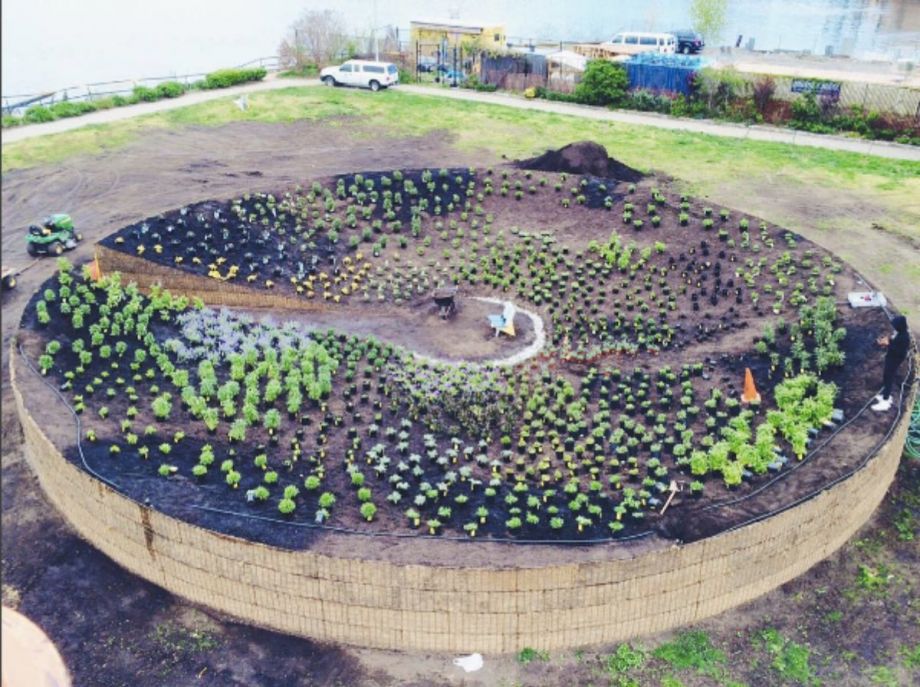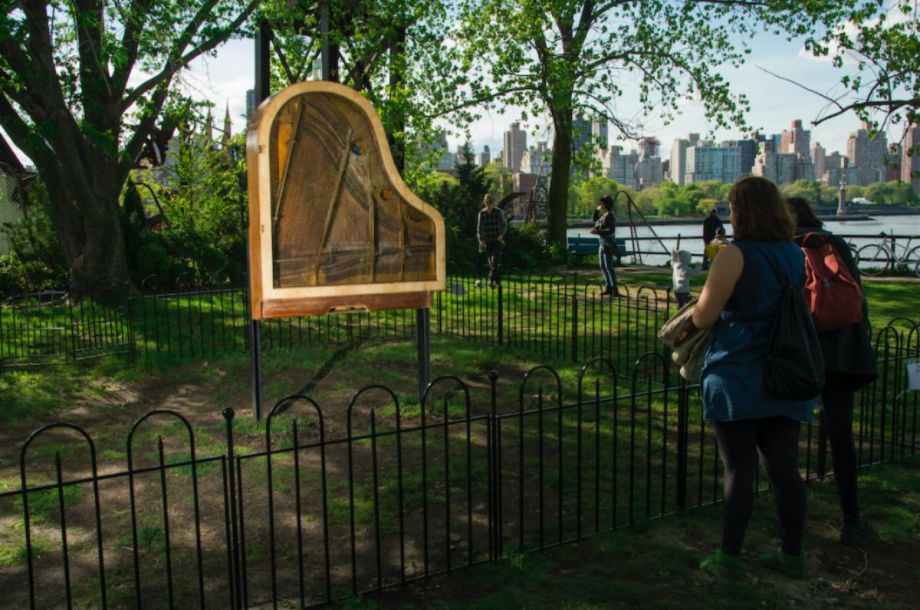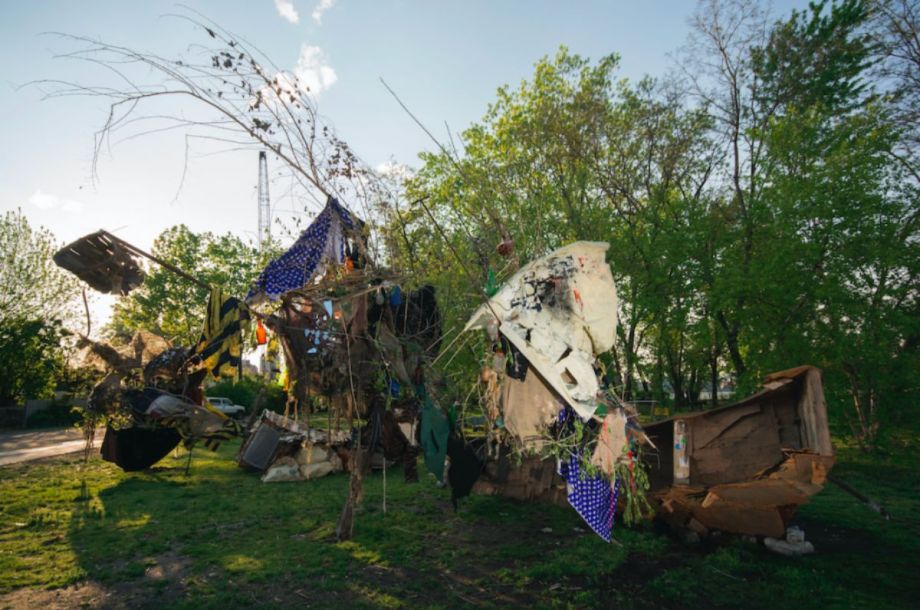A shipwreck. A salvaged piano humming with bees. A cotton picker and a football player facing off across a white line on a darkened field. Commemorating the 30th anniversary of Socrates Sculpture Park, these artworks and others are part of an exhibition, “Landmark,” that wrestles with issues of legacy, land use and ownership, in an oblique commentary on the park’s role as witness and partner in the transformation of Long Island City, Queens. This spring, the space also became officially mapped as New York City parkland, assuring that even as the neighborhood changes, it’s here to stay.
A former landfill and docking area, in 1986 Socrates became the first place in the New York metro area dedicated to exhibiting large-scale installations, thanks to the efforts of artist Mark di Suvero and the local residents who joined him. Since then, the site has remained committed to its community roots, even as it has contributed to the neighborhood’s emergence as an arts destination. All around the park, light industrial uses are being gobbled up by condominiums, blocks from the country’s largest public housing complex, all in the most ethnically diverse urban area in the world.
“Landmark” doesn’t address that development directly, but instead focuses on the grounds they all share — quite literally, the earth beneath their foundations. When di Suvero began to envision the abandoned lot near his studio as a sculpture park, it was a dumping site for demolished buildings and excavated dirt from a Manhattan subway project. He hired a few neighborhood residents to work on it with him, cleaning the site and reshaping the land. Volunteers followed.

The park under construction in the late 1980s (Credit: Socrates Sculpture Park)
In this Brooklyn-accented, immaculately soundtracked VHS homage to 1980s New York, two teenage boys tell the camera they like working on the park because they want to leave something behind. Sharon Lawson, a public housing resident, is seen on camera painting rocks down by the waterfront. “Come on down to the park and see how you like this, and maybe you can get into things: art, painting, drawing, making things, whatever,” she says. “I think that the sculpture park that’s coming up, I think it’s going to make a lot of people happy.”
Under the camera’s gaze, people and bulldozers scrape at the bare brown earth, grass sprouts, the land takes shape, and finally, sculptures appear.All of that was funded by the artists and neighbors themselves. The land was city-owned, but the city was happy enough to have someone else steward it. Socrates became a nonprofit, ultimately entering into a license agreement to maintain, operate and program a New York City public park. John Hatfield, the park’s executive director, says that relationship makes Socrates a very early model of a public-private partnership. Over time, the nonprofit formalized many of the relationships di Suvero originated. Instead of a haphazard mix of paid and volunteer workers, Socrates now runs an employment program with landscaping company Plant Specialists. Residents of the Astoria House public housing complex are hired as grounds crew, learning basic job skills and horticulture. If it goes well, Plant Specialists hires them full-time. (“It’s a kind of conduit to more substantive, gainful employment,” says Hatfield.) Maintaining the oasis in an urban environment demands continued stewardship.
Among the installations in the 30th anniversary exhibit is a large earthwork by Meg Webster, an artist known for sculptures that examine the construction and manipulation of nature. “Concave Room for Bees” resembles a perfectly circular raised garden bed, a bowl with walls of dirt 5 feet high, blooming with plants that attract pollinators. When the exhibition is over, the 300 cubic feet of dirt that make up the piece will be scattered across the property. Socrates’ soil remains low quality, the compacted remains of the landfill that was. So Webster’s earth will leave a lasting legacy, furthering the transformation of a pile of debris into a park.

Meg Webster's “Concave Room for Bees” (Credit: Socrates Sculpture Park)
Abigail DeVille’s sculpture looks to an older legacy: the European discovery and colonization of New York. Using reclaimed and found materials, she’s created a shipwreck of Henry Hudson’s boat, Half Moon, from which the installation draws its name. Hatfield says the work raises the question, “What exactly are you discovering when people are already living there?” — a question that could just as provocatively be asked of the gentrifying hordes leaving Manhattan for the outer boroughs.
Installed on Socrates’ waterfront, the piece also recalls that the water was once the least desirable place in the city. Sewage ran in the waters; prostitutes walked the docks. It’s no coincidence that much of New York’s public housing is on the water. Jessica Segall’s sculpture “Fugue in B flat” — a beehive installed inside a salvaged piano — recalls another twist of Queens history. The neighborhood was once a center of industry, known in particular for piano manufacturing.

Jessica Segall's “Fugue in B flat” (Credit: Socrates Sculpture Park)
Hatfield says as residential uses take over former manufacturing spaces, the economic makeup of the neighborhood is changing, but the park continues to attract a diverse group of visitors. Socrates’ goal is to present art that touches “the broadest spectrum possible,” says Hatfield. The park’s foreign film fest draws Brazilian residents to Brazilian movies, Albanian families to Albanian comedies. The park is always free, and offers a slate of no-cost programming from arts classes to tai chi to storytelling. About 20,000 families continue to live in the public housing around Socrates, says Hatfield, and they will remain a constituency that the park is committed to serve.
The recent official naming of Socrates as NYC parkland brings all visitors assurances: The space now can’t be taken out of use as a park. It’s a wonky distinction, but one that could lead to greater capital investment from the city, like shoring up the waterfront where Sharon Lawson did her painting 30 years ago; the area was damaged by Hurricane Sandy. Even as the neighborhood continues to change around it, Socrates wants to stay.
The Works is made possible with the support of the Surdna Foundation.
Jen Kinney is a freelance writer and documentary photographer. Her work has also appeared in Philadelphia Magazine, High Country News online, and the Anchorage Press. She is currently a student of radio production at the Salt Institute of Documentary Studies. See her work at jakinney.com.
Follow Jen .(JavaScript must be enabled to view this email address)

















